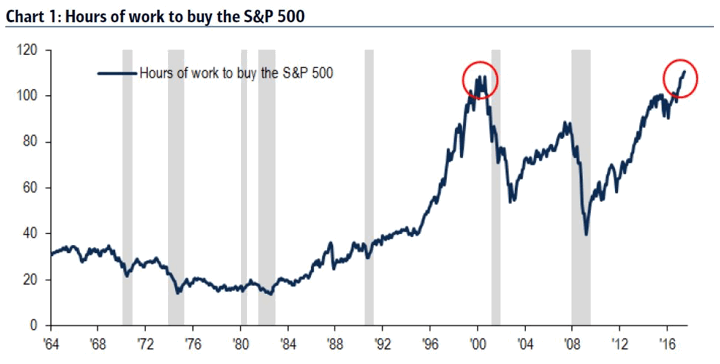As the US stock market keeps going up, it feels like everyone is whispering the same thing: We are near a top. It’s easiest to do this with numbers. Here’s a valuation metric that divides the price of the S&P 500 stock index by the median US hourly wage. In other words, how many hours of work does it take to buy a unit of the S&P 500?

Answer: More hours of work than even at the top of the 2000 tech bubble. Found via WSJ Daily Shot newsletter and @ReutersJamie. Original source appears to be BAML (Bank America/Merrill Lynch).
This concerns me of course, but I’m still a buy-hold-and-rebalance investor at roughly 2/3rd stocks and 1/3rd bonds. Sure, we might be at the top. But we could be at new top next week. There are two only possible states: all-time high or drawdown. Here’s a wise observation by @ClementsMoney:
The good news is, many investors are prepared for a stock market decline. The bad news is, they’ve been prepared since 2011.
 The Best Credit Card Bonus Offers – 2025
The Best Credit Card Bonus Offers – 2025 Big List of Free Stocks from Brokerage Apps
Big List of Free Stocks from Brokerage Apps Best Interest Rates on Cash - 2025
Best Interest Rates on Cash - 2025 Free Credit Scores x 3 + Free Credit Monitoring
Free Credit Scores x 3 + Free Credit Monitoring Best No Fee 0% APR Balance Transfer Offers
Best No Fee 0% APR Balance Transfer Offers Little-Known Cellular Data Plans That Can Save Big Money
Little-Known Cellular Data Plans That Can Save Big Money How To Haggle Your Cable or Direct TV Bill
How To Haggle Your Cable or Direct TV Bill Big List of Free Consumer Data Reports (Credit, Rent, Work)
Big List of Free Consumer Data Reports (Credit, Rent, Work)
Can you explain what does this mean, “The bad news is, they’ve been prepared since 2011.”? Thanks.
It means that they haven’t reaped the rewards of the ever increasing stock market while they have been sitting on the sidelines waiting.
The real bad news is the artificially manipulated stock market has been responsible for a good chunk of the gains since 2011, and that we will again stumble upon the can we have been kicking down the road.
If the stock market’s rise is a product of manipulation, then how will those who have been doing the manipulating escape blame for a stock market crash if they were to ever cease their manipulations?
Manipulation is a rather subjective word. Its entirely possible what you interpret is not what OP meant. At any rate, given manipulation or any sorts, whose to say they won’t be blamed? I’d encourage you to read The Big Short (watching it is okay but not as thorough). Manipulation of sorts happened. Trillions of wealth in the stock market was wiped out. Some actors were blamed (though rarely prosecuted) others weren’t.
Yeah, I just assumed he meant larger parties with more political motivations – central bankers, sovereign wealth funds, plunge protection teams and whatnot, buying up assets to keep prices from tumbling and mayhem ensuing.
Blame and prosecution are two different things
So a friend of mine pointed out a good point: wages have been stagnant so part of the reason for the difference is the fact that wages simply haven’t been growing, thus using a median wage would end up simply showing the S&P500 growth.
I have to agree with your friend. I don’t believe this chart gives us much insight into how expensive stocks are or whether we’re in a bubble. Earnings have steadily increased, the economy continues to grow, albeit slowly, and most of the leading economic indicators (ISM indexes, consumer and small business optimism, etc) are looking pretty good. I wouldn’t be surprised at a 10% pullback this year, but I believe it’ll be temporary.
Having said all that, the chart makes give me cause for concern over the long term. Ever increasing company earnings + wage stagnation is not sustainable in my mind. Something will have to give at some point.